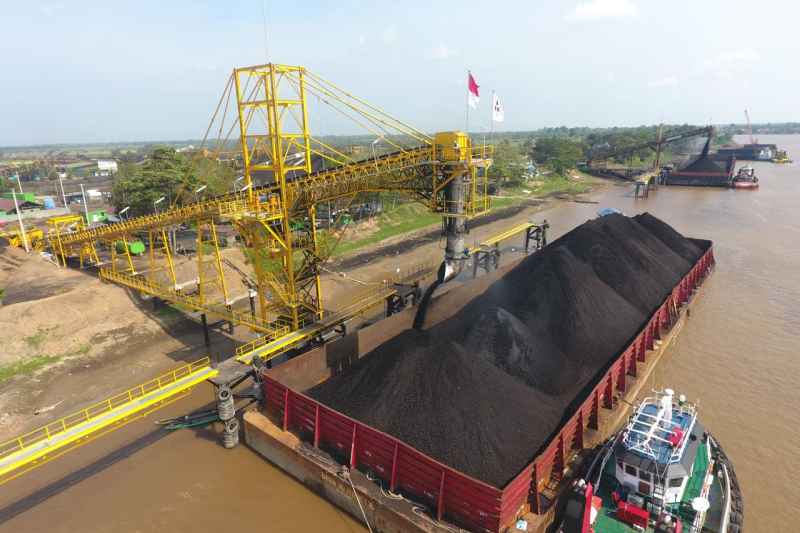The Minister of Energy and Mineral Resources (ESDM), Bahlil Lahadalia, has announced plans to issue a Ministerial Decree requiring exporters to use the Coal Benchmark Price (HBA) as the basis for transactions in the global market. This move aims to keep Indonesia’s coal prices stable, competitive, and in line with established standards.
In the 2024 Energy and Mineral Resources Sector Performance Conference held on Monday (February 3, 2025), Bahlil emphasized that this policy is intended to give Indonesia sovereignty over its own commodity pricing. If companies fail to comply with the HBA, the government has the authority to revoke their export permits as an enforcement measure.
Indonesia’s Coal Production Performance in 2024
According to the Ministry of Energy and Mineral Resources, total coal production in 2024 reached 836 million tons, surpassing the target of 710 million tons, achieving 117% of the goal. Of the total production:
- 233 million tons were allocated for domestic industrial needs (Domestic Market Obligation/DMO).
- 48 million tons were used for domestic coal stock.
- 555 million tons were allocated for export, accounting for approximately 33-35% of global coal consumption.
On a global scale, coal consumption currently reaches 8-8.5 billion tons, while the volume circulating in the international market is around 1.25 to 1.5 billion tons. Indonesia's significant contribution to the export market provides an opportunity to play a greater role in global coal price determination.
Impact of HBA Policy on Coal Price Stability
Bahlil stressed that even though coal production is increasing, maintaining a balance between supply and demand is crucial. If production exceeds demand, coal prices may plummet, ultimately harming national revenue and the mining industry.
The Ministry of Energy and Mineral Resources continues to monitor coal prices through various indices, including the Indonesia Coal Index (ICI). Each month, the government sets the HBA as a reference for determining royalty rates and coal sale prices in both domestic and international markets.
Titan Infra Sejahtera Strategy to Increase Coal Production Capacity
To support the growth of the coal industry, various mining companies, including Titan Infra Sejahtera Group, have implemented strategic measures to enhance production capacity and operational efficiency. Key factors driving coal production growth in Indonesia include:
1. Rising National Energy Demand
Indonesia's rapid economic and population growth has significantly increased energy demand. Coal remains the primary energy source in the national energy mix, especially for steam power plants (PLTU).
2. Development of New Power Plants
Investment in Independent Power Producers (IPP) continues to expand, with several new projects such as the IPP Power Plan Sumsel 8 and Sumbagsel 1 in Baturaja requiring a stable and sufficient coal supply.
3. Expanding Export Market Potential
Demand for coal in international markets remains strong, particularly from countries such as China, India, and Japan. This presents an opportunity for Indonesia to further increase export volumes and maximize revenue from the mining sector.
Titan Infra Sejahtera's Contribution to Mining Infrastructure Development
As a key player in the mining industry, Titan Infra Sejahtera Group has developed an integrated infrastructure system to enhance efficiency in coal mining operations. The developed infrastructure includes:
1. PT Servo Lintas Raya (SLR)
- Provides integrated logistics solutions for coal mining in South Sumatra.
- Operates a dedicated 118 km coal transportation route.
- Maintains a stockpile with a capacity of 800,000 tons.
- Operates five weighbridge units to ensure efficient coal distribution.
2. PT Swarnadwipa Dermaga Jaya (SDJ)
- Manages a 62-hectare coal loading port in Muara Lematang, Pali Regency.
- Features a coal crusher facility and a stockpile with a capacity of 400,000 tons.
- Equipped with two Barge Loading Conveyors (BLC) with a capacity of 8,000 tons per hour.
3. PT Maritim Sumber Energi (MSE)
- Operates a dedicated coal loading terminal in Bengkulu.
- Has a water draft of five meters, capable of handling barges up to 300 feet.
- Maintains a stockpile capacity of 250,000 tons.
The Future of Indonesia’s Coal Industry
With stricter regulations and massive infrastructure development, Indonesia has great potential to become a leader in the global coal industry. The Minister of Energy and Mineral Resources’ policy of maintaining coal price stability through HBA is expected to provide certainty for industry players while enhancing the competitiveness of Indonesia's coal exports.
The sustainability of the coal industry also depends on energy diversification, technological innovation, and the implementation of sustainable mining principles that prioritize environmental and social aspects.
 The Strategy of the Minister of Energy and Mineral Resources in Maintaining Coal Price Stability and the Coal Industry’s Efforts to Increase Production Capacity
The Strategy of the Minister of Energy and Mineral Resources in Maintaining Coal Price Stability and the Coal Industry’s Efforts to Increase Production Capacity